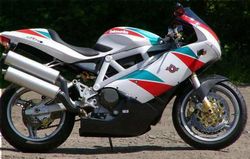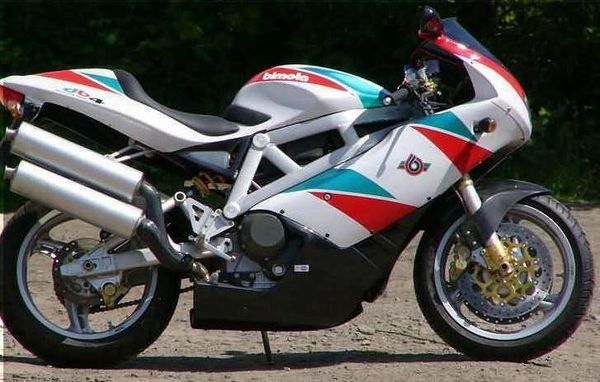Bimota DB4 Half fairing
 |
|
| Bimota DB4 Half fairing | |
| Manufacturer | |
|---|---|
| Production | 264 units |
| Engine | Four stroke, 90°Ltwin cylinder, SOHC, desmodromic 2 valves per cylinder |
| Compression ratio | 9.2:1 |
| Top Speed | 212 km/h / 131 mph |
| Ignition | Electronic inductive |
| Transmission | 6 Speed |
| Suspension | Front: Telehydraulic fork with 43mm stanchions and preload adjustments Rear: Fully adjustable monoshock absorber, swingarm |
| Brakes | Front: 2x 320mm discs Rear: Single 230mm disc |
| Front Tire | 120/70 ZR17 |
| Rear Tire | 180/55 ZR17 |
| Wheelbase | 1370 mm / 53.9 in. |
| Seat Height | 800 mm / 31.5 in. |
| Weight | 165 kg / 363.8 lbs (dry), |
| Fuel Capacity | 20 Liters / 5.3 US gal |
| Manuals | Service Manual |
It could reach a top speed of 212 km/h / 131 mph.
Engine[edit | edit source]
The engine was a Air cooled cooled Four stroke, 90°Ltwin cylinder, SOHC, desmodromic 2 valves per cylinder. The engine featured a 9.2:1 compression ratio.
Chassis[edit | edit source]
It came with a 120/70 ZR17 front tire and a 180/55 ZR17 rear tire. Stopping was achieved via 2x 320mm discs in the front and a Single 230mm disc in the rear. The front suspension was a Telehydraulic fork with 43mm stanchions and preload adjustments while the rear was equipped with a Fully adjustable monoshock absorber, swingarm. The DB4 Half fairing was fitted with a 20 Liters / 5.3 US gal fuel tank. The bike weighed just 165 kg / 363.8 lbs. The wheelbase was 1370 mm / 53.9 in. long.
Photos[edit | edit source]
Overview[edit | edit source]
Bimota DB4
Bimota has looked to a
lean and simple V-twin to help pull it out of the smelly stuff. Back in
1985, the sales success of the DB1, its first ever Ducati-powered model,
rescued the firm from a financial crisis. Now Tognon and his team are hoping
they can pull off the same trick with the 1154, which combines the engine
from Ducati's latest 900SS with an oval-tube aluminum chassis similar to
that of the loopy Mantra roadster.
As usual Bimota doesn't make any internal changes to the 9()4cc,
air/oil-cooled V-twin. Ducat) uprated the old sohc two-valves-per-cylinder
lump for last year's 900SS, giving it new cams for slightly better breathing
at high revs, Bimota adds its own twin-pipe exhaust and, surprisingly,
replaces the Duke's new fuel-injection system with the previous model's 38mm
Mlkunl carbs, complete with Bimota-designed airbox.
The chassis layout is almost identical to that of the Mantra, based
around a triangulated tubular aluminum frame that weighs just 5kg. The
cantilever swing arm - also aluminum -operates a diagonally-mounted Öhlins
shock. At the sharp end, 43mm Paioli forks are held at a steep 23° angle.
Let's throw in some more little figures. With a wheelbase of just 1370mm,
a seat height of 800mm and a dry weight of only 165kg, Bimota's DB4 is
shorter, lower and lighter than Yamaha's R6. Even short riders will be able
to plant both feet firmly on the ground, and you barely have to reach
forward to the low clip-ons.
Like the 900SS, the DB4 won't appeal much to riders who demand power and
speed above all else. The Duke's claimed peak output is a mere 80bhp at
7500rpm, and although the Bim's free-breathing exhaust means it barks
louder, it doesn't have any more bite. Like the 900SS, though, the DB4
combines punchy mid-range with the old air/oil-cooled V-twin's lumpy charm.
The use of carbs retains the DB series' traditional simplicity, and
they're cheaper. But during my ride on the hilly, twisty roads inland from
Rimini, the Bim suffered from an erratic idle and an occasional slight
glitch just below 5000rpm, suggesting the Mikunis needed better setting-up.
That didn't prevent the DB4 from being brilliant fun. Its low-rev
snatchiness cleared at about 3000rpm. There was good power from four grand
and even more from about five, before the sohc motor began to run out of
puff at eight thou, 1000rpm or so short of the limit. In the 60-110mph zone
where you spend most time on the road it was seriously rapid, aided by its
light weight and broad spread of torque.
Acceleration tailed off above about 120mph, but with its pilot hiding
behind the low screen, it would probably reach 135mph. More power would
occasionally be nice, but on these roads that was plenty. Throttle action
was light, the six-speed gearbox sweet, and the mid-range grunt made
clutchless wheelies a doddle.
The DB4 lives up to Bimota's tradition for light, rigid chassis. With
such sharp geometry and so little weight the little twin can be chucked
around with ease, flicking rapidly from side to side with minimal pressure
on the bars. Yet, apart from a slight tendency to be shunted off line by
bumps in the road, it was super-stable too.
Much of the credit for that goes to the suspension. The fairly firm,
multi-adjustable Paioli forks gave good feedback and helped make
this one of the sweetest-steering bikes on the road. And the Öhlins shock
was excellent, keeping the rear end under control even when the Bimota was
accelerating hard out of bumpy corners.
The familiar braking blend of 320mm Brembo discs and four-pot calipers
had plenty of bite, although needing a fair bit of lever pressure. Pirelli's
super-sticky Dragon Corsa radials found grip, even in the most dubiously
surfaced bends. My only cornering problem was that in turns my right size 11
sometimes tangled with the carbon-fibre exhaust shield, which is too close
to the footrest.
Other carbon parts and the DB4's patriotic red-white-green bodywork were
finished to the high standard expected of Bimota, but not always achieved in
the past. New boss Tognon is conscious that, as a manufacturer of
premium-priced bikes, Bimota's quality must be impeccable. By Rimini
standards the hand-assembled DB4 is competitively priced, but it's still
more expensive than plenty of the far faster mass-produced machines.
Overall it's hardly a leap forward from the DB2 of a few years ago.
Same cobby engine, same flickable handling, same minimalism and overtly
'Italian special' styling. A tried and trusted evolution of a theme, and
ideal for rebuilding trust in a company that needs it.
But after all the niche assessment that a bike like this evokes never
forget that the DB4 is a seriously sexy ride.
Source Bike Magazine of 1999{| class="wikitable"
|-
!Make Model
|Bimota DB4
|-
!Year
|1998
|-
!Production
|264 units
|-
!Engine Type
|Four stroke, 90°Ltwin cylinder, SOHC, desmodromic 2 valves per cylinder
|-
!Displacement
|904cc / 55.2 cub in.
|-
!Bore X Stroke
|92 x 68 mm
|-
!Compression
|9.2:1
|-
!Cooling System
|Air cooled
|-
!Induction
|2x 38mm Mikuni carbs
|-
!Ignition
|Electronic inductive
|-
!Starting
|Electric
|-
!Max Power
|58.3 kW / 80 hp @ 7000 rpm
|-
!Max Torque
|81 Nm / 8.3 kgf-m / 59.7 lb-ft @ 7000 rpm
|-
!Transmission
|6 Speed
|-
!Lubrication
|Wet sump
|-
!Final Drive
|Chain
|-
!Front Suspension
|Telehydraulic fork with 43mm stanchions and preload adjustments
|-
!Rear Suspension
|Fully adjustable monoshock absorber, swingarm
|-
!Front Brakes
|2x 320mm discs
|-
!Rear Brakes
|Single 230mm disc
|-
!Front Tire
|120/70 ZR17
|-
!Rear Tire
|180/55 ZR17
|-
!Rake
|23°
|-
!Wheelbase
|1370 mm / 53.9 in.
|-
!Seat Height
|800 mm / 31.5 in.
|-
!Dry Weight
|165 kg / 363.8 lbs
|-
!Fuel Capacity
|20 Liters / 5.3 US gal
|-
!Consumption Average
|5.1l /100km / 46.1 mpg
|-
!Standing ¼ Mile
|12.1 sec
|-
!Top Speed
|212 km/h / 131 mph
|}
